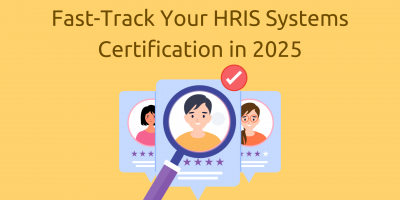
Fast-Track Your HRIS Systems Certification in 2025
In a world driven by digital tools and transformations, where does your HR skill set stand?

Employee motivation is vital for the success of every business.
If your team “quietly quits” and mentally disengages from their work, office productivity slows, employee turnover increases, and the company’s bottom line suffers.
One popular way to keep employees happy and productive is to use incentives, such as rewards, bonuses, and promotions, to motivate them.
But do these incentives work, and what are the best employee incentive programs out there?
Below, we examine 21 different examples of motivating employees, the pros and cons of each, and how these incentive programs can be put into action.
Incentive programs use a structured approach to reward and recognize desired behaviors from a specific group of people.
These programs can be found in numerous settings, from schools and workplaces to customer loyalty schemes and community initiatives.
So, what is an incentive program in a corporate setting?
In the business world, these programs can take various forms, such as sales incentives to boost performance metrics, employee incentives to encourage workplace productivity or retention, customer incentives to enhance loyalty or brand advocacy, and many more.
Surprisingly, the rewards in these programs are often non-cash, like points-based merchandise, group travel, or gift cards, because non-cash rewards tend to have a more significant long-term motivational impact because of their social and emotional value.
When executed well, these programs can lead to increased motivation, higher job satisfaction, and stronger loyalty toward the organization.
In the context of the workplace, employee incentive programs are all about encouraging employees to go above and beyond. It is a company’s appreciation and recognition of their employees’ hard work and contributions.
From simple thank-you notes and public acknowledgments to more tangible rewards like bonuses, extra vacation days, or even stock options, the variety within these programs is unmatched.
Ultimately, the main goal is to create a win-win situation where employees are motivated to do their best, knowing their efforts won’t go unnoticed. In turn, companies can enjoy increased productivity and loyalty.
Corporate incentive programs come with their own set of advantages and challenges.
On the plus side, they can be strong motivators for employees, leading to improved performance and productivity. They’re also great for building a positive company culture where employees feel appreciated and valued.
This, in turn, can boost employee retention rates, saving companies the time and cost associated with high turnovers. Studies support this notion, with turnover rates being reduced by over 26% for companies with solid incentive programs.
However, if not carefully designed, these programs can lead to unhealthy competition among employees.
Incentive programs for employees can sometimes lead to a “what’s in it for me?” attitude, where the focus shifts from the team’s success to individual rewards.
There’s also the risk of these rewards being seen as entitlements, which can diminish their impact over time.
Finally, poorly structured programs might inadvertently incentivize the wrong behaviors, leading to a focus on short-term gains over long-term growth and development.
In essence, while incentive programs can be powerful tools for boosting performance and morale, they must be crafted carefully to ensure they’re hitting the mark without any negative side effects.
Recognizing and rewarding employees for their performance or achieving specific goals is perhaps the most popular financial incentive. In fact, 65% of employees prefer bonuses based on their personal accomplishments. That said, employers must set clear metrics and objectives so employees know exactly how to reach these goals.

Recognition awards formally and publicly acknowledge employees’ hard work and dedication. These awards can take many forms, from prizes for achieving milestones to informal kudos for everyday contributions.
Companies are increasingly using platforms like Awardco and Assembly Recognition Software to integrate recognition into their day-to-day workplace culture.
In a profit-sharing incentive program, the company pays its employees a portion of the profits. Profit-sharing plans are very versatile and can be based on quarterly or annual earnings. At the same time, employees can receive their payments as contributions to their retirement funds or get direct payments too. This approach ties the employees’ rewards directly to the company’s success, incentivizing them to contribute to the business’s profitability and growth.
Employee Stock Ownership Plans (ESOPs) offer workers ownership interest in the company, typically at no upfront cost.
In other words, employees usually don’t buy shares directly. Instead, the company provides shares to the employees, often based on their salary level and tenure at the company.
ESOPs are powerful tools for increasing employee engagement, as workers who feel like owners are more likely to be committed to the company’s success.
Investing in employees’ development and professional growth is crucial for employee retention and satisfaction.
According to reports, much as 94% of employees would stay with their employer longer if the company invested in their career development.
Companies offering training, further education, and many advancement opportunities have a better-skilled workforce and, at the same time, demonstrate their investment in their workforce.
One non-financial incentive for employees is rewarding them with better flexibility at work, which also promotes a healthy work-life balance. Flexible work arrangements, including remote work, flexible hours, and part-time options, cater to employees’ diverse needs and lifestyles and are especially valued by busy parents and caregivers.
Employee referral programs incentivize existing employees to recommend qualified candidates for open positions.
As a result, this approach speeds up the hiring process and brings in talent that is likely a good cultural fit, given the personal endorsement. According to research, 88% of employers find that such programs are the best way to recruit top talent.
Performance recognition platforms like Workproud and Guusto provide a structured way to acknowledge and reward employees for their achievements. These platforms can automate the recognition process, making it easy to celebrate milestones, share success stories, and reinforce the behaviors that lead to business success.
A professional development allowance supports employees in pursuing learning opportunities outside the workplace, such as conferences, workshops, or courses.
These investments can especially impact a business’s profitability as they allow employees to stay updated with industry trends, discover new talents, and gain expertise for higher positions.
Leadership development programs are designed to cultivate the next generation of company leaders by providing them with the training and experiences necessary to succeed in higher-level roles. These programs are crucial for succession planning and ensure the company has a strong pipeline of capable leaders.
Mentorship programs pair less experienced employees with seasoned professionals to guide their development and career progression.
These programs create knowledge transfer, strengthen skill development, and raise the confidence and capabilities of mentees. Companies with a supportive and growth-oriented work environment will also have a highly motivated workforce.
Employee discounts on products or services are a straightforward yet effective way to make employees feel appreciated and create a sense of exclusivity. Discounts on corporate products, partnerships with local businesses, or entry to entertainment venues are common ways to create a stronger connection to the brand.
A peer-to-peer recognition program is a system that allows employees to recognize their colleagues’ contributions. This recognition can take different forms, from monetary rewards, such as gift cards or points, to meaningful expressions of gratitude, such as personalized messages.
Platforms like Nectar support these initiatives by strengthening team cohesion and building an atmosphere where everyone feels seen and appreciated.
Offering travel perks is a fantastic way to inspire and motivate teams. This could range from exciting business trips and bonding team retreats to travel vouchers. For companies looking for something simpler, consider offering hotel discounts, flight deals, or even free car rentals.
Take Online Rewards, for instance – their travel catalog is packed with options, from exotic adventures to fun family vacations, all aimed at rewarding employees.
Companies are increasingly rolling out employee sabbaticals as a perk and employee incentive. Sabbaticals provide long-term employees with an extended break from work, allowing them to pursue personal interests, rest, or further their education.
While there are several practical aspects to consider, such as who is eligible, if it’s paid or unpaid leave, and benefits management during the sabbatical, this benefit can motivate and rejuvenate employees.
Employee Stock Purchase Plans (ESPPs) allow employees to purchase company stock at a discounted rate, usually up to 15%.
When employees earn an equity stake in their company, it creates a sense of ownership and investment in the company’s success. For these reasons, ESPPs can be an excellent financial benefit and boost employee engagement and loyalty.

Flexible benefits packages allow employees to customize their benefits and tailor their compensation packages to their needs and lifestyles. This approach, which can include a range of benefits from medical opt-out to dental plans and health savings accounts (HSA), recognizes the unique preferences of each employee.
Innovation awards recognize and reward employees who propose new ideas, improvements, or inventions that benefit the company. Celebrating these achievements can motivate the entire workforce to think outside the box and contribute to the company’s evolution.
Family-friendly policies, such as parental leave, childcare support, and flexible scheduling, cater to employees with family responsibilities. These policies demonstrate the company’s understanding and support for the work-life balance challenges faced by employees, leading to higher job satisfaction, loyalty, and a more inclusive workplace culture.
Cross-training opportunities allow employees to learn different aspects of the business, gain new skills, and increase their adaptability within the company. These opportunities benefit the employees in their personal growth and, at the same time, create internal mobility and flexibility within the company.
Profit-sharing trusts are a form of profit sharing where profits are deposited into a trust account and distributed among employees, typically based on their salary levels and tenure. This incentive reinforces the belief that all employees have a hand in the company’s success and reap the benefits, which promotes a collective drive towards shared objectives.
Here are some best practices for offering incentives to employees:
Incentive programs have become commonplace, and many companies are adopting and implementing these recognition programs to retain their best employees.
For example, DreamWorks has unique offerings like exclusive art shows, movie screenings, and enriching art classes, which transform the workplace into a space for continuous learning and inspiration.
Similarly, Southwest Airlines, known for its peer-to-peer recognition program SWAG, allows employees to acknowledge and award one another with points. These points can be used for various rewards, from merchandise to travel discounts.
Another notable initiative is Instacart’s “Four Year Fill-Up” program, which offers employees a four-week sabbatical after their four-year tenure that rewards long-term commitment.
On the other hand, Google, known for its innovative employee benefits and unique perks from on-site recreational facilities to extensive health and wellness coverage, has even unique policies like allowing 20% of the work week to be used on passion projects.
However, incentives don’t have to be grand to be meaningful.
At Salesforce, employees use Slack for shoutouts and special badges, making everyday achievements feel important. Therefore, it’s no surprise that Salesforce ranked 4th on the 2023 Great Places to Work in the US list.
These stories show how diverse and creative incentive programs can make work more rewarding and keep employees happy.
Navigating through various employee incentive tools, it’s evident that there is no one-size-fits-all solution.
However, one thing is clear: the best employee incentive programs are those that can connect and inspire the employees they’re designed for.
In other words, the success of any incentive program lies in its ability to resonate with the employees it aims to motivate.
Disclosure: Some of the products featured in this blog post may come from our partners who compensate us. This might influence the selection of products we feature and their placement and presentation on the page. However, it does not impact our evaluations; our opinions are our own. The information provided in this post is for general informational purposes only.
Senior Content Writer at Shortlister
Browse our curated list of vendors to find the best solution for your needs.
Subscribe to our newsletter for the latest trends, expert tips, and workplace insights!

In a world driven by digital tools and transformations, where does your HR skill set stand?

To successfully navigate the current job market, hiring managers should consider what job seekers most value or dislike about a job. That is where employee personas can come in handy.
NOTE: The opinions in this article are the author’s and do not necessarily represent the views of Shortlister Each year we see technology having an

Beyond step counters and group exercise, corporate fitness challenges inspire movement in the company’s bottom line, but only when done right.
Used by most of the top employee benefits consultants in the US, Shortlister is where you can find, research and select HR and benefits vendors for your clients.
Shortlister helps you reach your ideal prospects. Claim your free account to control your message and receive employer, consultant and health plan leads.